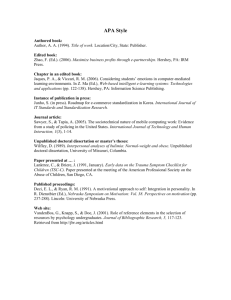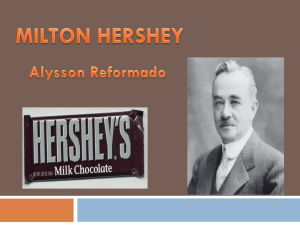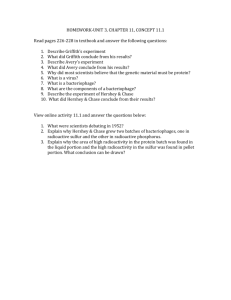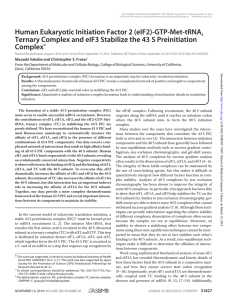John W.B. Hershey, Ph.D., Ph.D.
advertisement
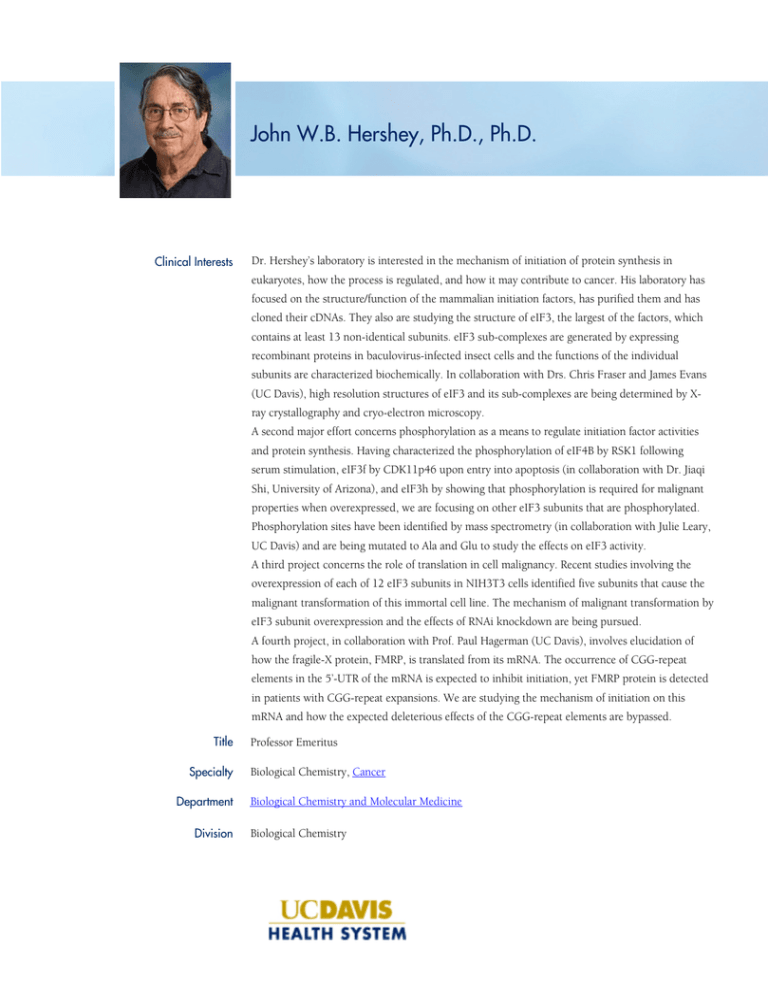
John W.B. Hershey, Ph.D., Ph.D. Clinical Interests Dr. Hershey’s laboratory is interested in the mechanism of initiation of protein synthesis in eukaryotes, how the process is regulated, and how it may contribute to cancer. His laboratory has focused on the structure/function of the mammalian initiation factors, has purified them and has cloned their cDNAs. They also are studying the structure of eIF3, the largest of the factors, which contains at least 13 non-identical subunits. eIF3 sub-complexes are generated by expressing recombinant proteins in baculovirus-infected insect cells and the functions of the individual subunits are characterized biochemically. In collaboration with Drs. Chris Fraser and James Evans (UC Davis), high resolution structures of eIF3 and its sub-complexes are being determined by Xray crystallography and cryo-electron microscopy. A second major effort concerns phosphorylation as a means to regulate initiation factor activities and protein synthesis. Having characterized the phosphorylation of eIF4B by RSK1 following serum stimulation, eIF3f by CDK11p46 upon entry into apoptosis (in collaboration with Dr. Jiaqi Shi, University of Arizona), and eIF3h by showing that phosphorylation is required for malignant properties when overexpressed, we are focusing on other eIF3 subunits that are phosphorylated. Phosphorylation sites have been identified by mass spectrometry (in collaboration with Julie Leary, UC Davis) and are being mutated to Ala and Glu to study the effects on eIF3 activity. A third project concerns the role of translation in cell malignancy. Recent studies involving the overexpression of each of 12 eIF3 subunits in NIH3T3 cells identified five subunits that cause the malignant transformation of this immortal cell line. The mechanism of malignant transformation by eIF3 subunit overexpression and the effects of RNAi knockdown are being pursued. A fourth project, in collaboration with Prof. Paul Hagerman (UC Davis), involves elucidation of how the fragile-X protein, FMRP, is translated from its mRNA. The occurrence of CGG-repeat elements in the 5’-UTR of the mRNA is expected to inhibit initiation, yet FMRP protein is detected in patients with CGG-repeat expansions. We are studying the mechanism of initiation on this mRNA and how the expected deleterious effects of the CGG-repeat elements are bypassed. Title Specialty Department Division Professor Emeritus Biological Chemistry, Cancer Biological Chemistry and Molecular Medicine Biological Chemistry John W.B. Hershey, Ph.D., Ph.D. Center/Program Affiliation Select Recent Publications UC Davis Comprehensive Cancer Center Fraser, C.S., J.W. Hershey and J.A. Doudna The pathway of hepatitis C virus mRNA recruitment to the human ribosome. Nat. Struct. Mol. Biol. 2009. 16, 397-404. Ludwig, A.L., C. Raske, F. Tassone, D. Garcia-Arocena, J.W. Hershey and P.J. Hagerman Translation of the FMR1 mRNA is not influenced by AGG interruptions. Nucl. Acids Res. 2009. 37, 6896-6904. Shi,J, J.W. Hershey and M.A. Nelson Phosphorylation of the eukarhyotic initiation factor 3f by cyclin dependent protein kinase 11 during apoptosis. FEBS Lett. 2009. 583: 971-977. Fraser, S.C., K.E. Berry, J.W.B. Hershey and J.A. Doudna eIF3j is located in the decoding center of the human 40S ribosomal subunit. Molec. Cell 2008. 26, 811-819. Damoc, E., C.S. Fraser, M. Zhou, H. Videler, G.L. Mayeur, J.W.B. Hershey, J.A. Doudna, C.V. Robinson and J.A. Leary Structural Characterization of the Human Eukaryotic Initiation Factor 3 Protein Complex by Mass Spectrometry. Mol. Cell. Proteomics 2008. 6: 1135-1146. Zhang, L., Z. Smit-McBride, X. Pan, J. Rheinhardt and J.W.B.. Hershey An Oncogenic Role for the Human Translation Initiation Factor eIF3h. J. Biol. Chem. 2008. 283: 24047-24060. Zhou, M., A.M. Sandercock, C.S. Fraser, G. Ridlova, E. Sstephens, M.R. Schenauer, T. Yokoi-Fong, D. Baarsky, J.A. Leary, J.W.B. Hershey, J. Doudna and C.V. Robinson Mass spectrometry reveals modularity and a complete subunit interaction map of the eukaryotic translation factor eIF3. Proc. Natl. Acad. Sci. 2008. USA 105: 18139-18144. Zhang, L., X. Pan and J.W.B. Hershey Individual Overexpression of Five Subunits of Human Translation Initiation Factor eIF3 Promotes Malignant Transformation of Immortal Fibroblast Cells. J. Biol. Chem. 2007. 282: 5790-5800. © 2016 UC Regents

